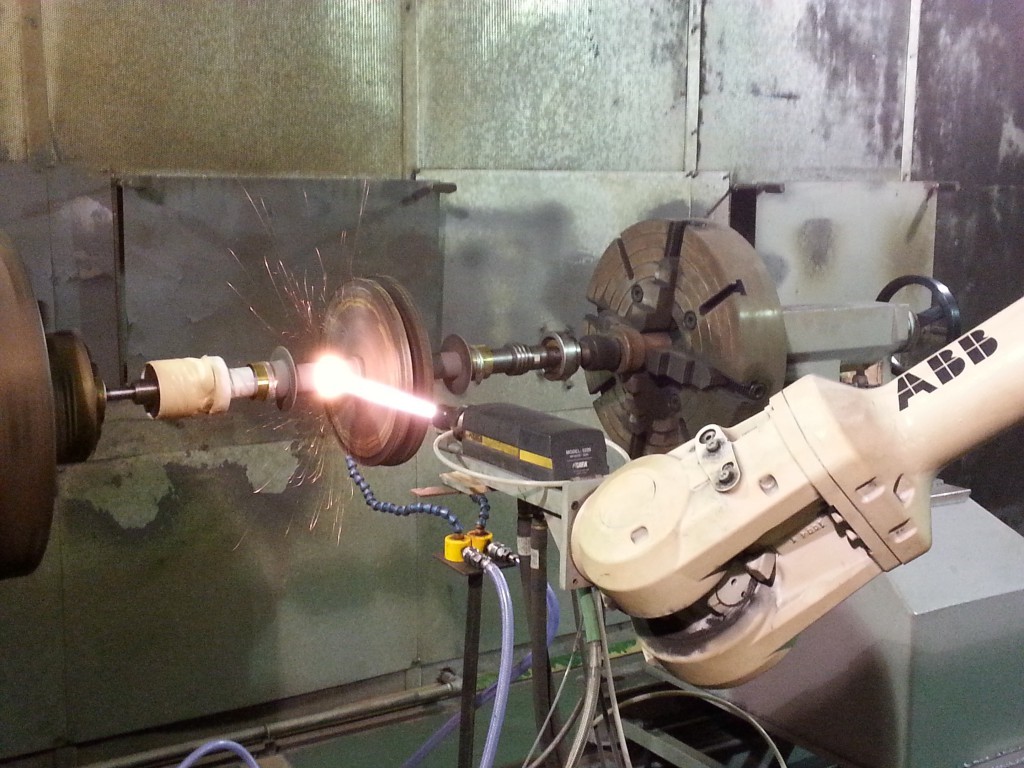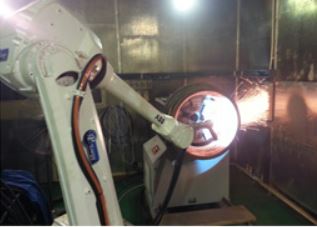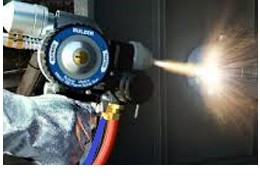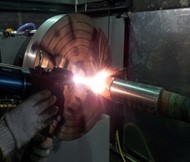Thermal spraying is a technology that uses combustion heat flame or electrical energy to adhere or fuse various types of materials, forming a coating on the surface of the substrates, and adding a high-quality, high-performance surface covering for a variety of equipment and devices. Improves or restores the surface of a solid material. The process can be used to apply on a wide range of materials and components, to provide resistance to: wear, erosion, cavitation, corrosion, abrasion or heat. This technology is heavily used in all types of industrial sectors for component upgrading and diversification, as well as improving and enhancement of substrates with new functions.
HVOF
HVOF (High Velocity Oxy Fuel)
High velocity oxy fuel (HVOF) is a coating process most often used for chrome replacement. Tungsten carbide cobalt chromium (WC Co Cr) and chrome carbide, CrCNiCr are two of the most common powder-materials used to replace chrome. It involves using a spray device into which the metal powder, oxygen and a fuel gas such as kerosene, propane or propylene or natural gas is introduced. The gas is ignited, heating and accelerating the powder particles which are sprayed onto the work piece at high velocity. The sprayed powder particles impact the work piece and form splats which are built up to make the coating in layers. The bond between the coating and the work piece is a mechanical bond with bond strengths of greater than 10,000 psi. Tensile tests are performed in accordance with ASTM C633. HVOF coatings have porosities of less than 1%. The density of HVOF coatings is the reason for their excellent corrosion, wear & abrasion resistance.
Features and Benefits:
- Extremely good for coating Tungsten and Chrome carbide for wear and abrasion applications
- Low oxide metallic coatings.
- Optimized microhardness using carbides.
- Excellent machined surface finish.
- Superior adhesion, bond strength.
- Fine micro structure
- Very dense and low porous coatings
- Finishes to an extremely smooth surface
- Optimal micro hardness
- Excellent corrosion properties
- Excellent for hard metal (carbide coatings)
- Low degree of oxidation, lower stresses build up or residual stresses at the work piece
Common feedstock material:
Stainless Steel, Tungsten Carbide, Chrome Carbide, Colmonoy, Stalite Inconel, Hestalloy etc
Typical Applications:
- Sealing moving surfaces to prevent seals from leaking
- Improvement of wear resistance and chemical protection of ball valves
- Protection of hydraulic piston rods against sea-water environment in the offshore industry
- Repairs and dimension corrections of worn drive shafts and bearing seatings
- Substrate for Thermal Barrier Coatings (TBCs)
- Cavitation protection in hydro electric power stations
- Protection of pump casings and impellers against chemical corrosion
- Hydraulic and Pneumatic Piston Rods and Cylinders Mud Rotors
Twin Wire Arc Spray
Twin Wire Arc Spray
Wire arc spray is a form of thermal spraying where two consumable metal wires are fed independently into the spray gun. These wires are then charged and an arc is generated between them. The heat from this arc melts the incoming wire, which is then entrained in air jet from the gun. This entrained molten feedstock is then deposited onto a substrate. This process is commonly used for metallic, heavy coatings.
It advantages high deposition rate and economic sense to achieve much critical application with the commonly available feedstock wires. Its ability of special feedstock wires with cored powdered has improved and widened up its application area.
- No combustion gas.
- Easy to operate.
- High production spray rates.
- Excellent coating bond strength and density
- Fast deposition and thickness build up
- Excellent coating strength and density compared to Wire flame spray.
- Transportable process, coating on location possible
- Moderate tensile strength
- Good compressive strength
Common feedstock material: Aluminum, Stainless Steel, Aluminum Bronze, SS316/SS420, Tafa 95MXC, Cored wires
Typical Applications:
- TSA for atmospheric and heat corrosion control.
- Rebuild and salvage operations.
- Boiler walls of incinerators against high-temperature erosion and chemical degradation
- Repairs and dimension corrections of worn drive shafts and bearing seatings with nickel-based alloys
- Corrosion protection for locks, bridges, etc. with aluminium, zinc and alloys
- Electrical shielding with tin, zinc, etc.
- Anti skid and traction coatings
Flame Wire Spray
Flame Wire Spray
Wire flame spraying process uses metals and alloys in wire form as its spraying materials and combustion flame as its heat source. The molten materials are sprayed onto the surface of the subject to form the coating.
Its advantages include the mobility of the system allow site jobs such as refinery high-level column for thermal spray aluminium coating on corrosion under insulation protection for live equipment. Besides its capability of assessment to the inner part of the internal section with special tooling attached.
Features & Benefits:
- Micro porous lamellar structure
- Relatively high degree of oxidation in the coating
- Moderate tensile strength
- Good compressive strength
- Low elongation properties
- Economic thermal spraying process
- Transportable process, coating on location possible
Common feedstock: Molybdenum, Zinc, SS420, SS316
Typical Applications:
- Boiler walls of incinerators against high-temperature erosion and chemical degradation
- Repairs and dimension corrections of worn drive shafts and bearing seating with nickel-based alloys
- Corrosion protection for locks, bridges, etc. with aluminium, zinc and alloys
- Electrical shielding with tin, zinc, etc.
- Anti-skid and traction coatings
Rokide Spray
Rokide Spray
The Rokide Spray System is a unique process utilizing ceramic oxide rods. The resulting ceramic-based coating provides excellent durability under extremely demanding conditions. Rokide coating is especially suited for applications requiring extreme dry abrasion wear resistance. Industries such as paper, petrochemical, oil, wire, and aviation/aerospace benefit tremendously from Rokide ceramic coatings.
Its advantages include enhancement of electrical insulation, heat resistant, wear resistance, superior corrosion resistant earn recognition.
Features & Benefits:
- Expensive rod materials
- Cheaper and easy to operate
- Good resistance to mechanical friction
- Very good abrasion resistance
- For hardness and inert to chemical
- High temp resistant
- Non-conductive electrically
Common feedstock: Aluminium Oxide, Chromium oxide
Typical Applications:
- Corrosive and high temperature application.
- Chemical and semicon
- Mechanical Seal’s faces
- Valve Stem
- Ball Valve
- Wire drawing capstan
- Wire Pulleys
- Oil Seals
- Pump Sleeves & Shafts, Impellers & Casings
- Press Rolls




